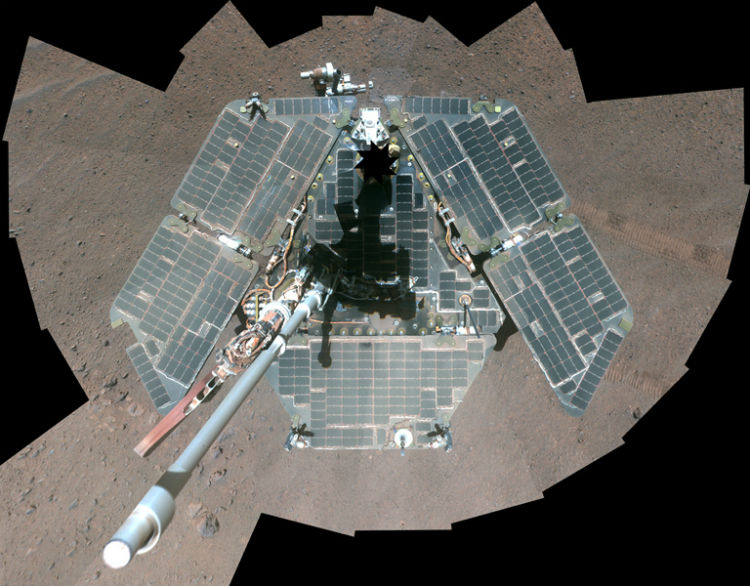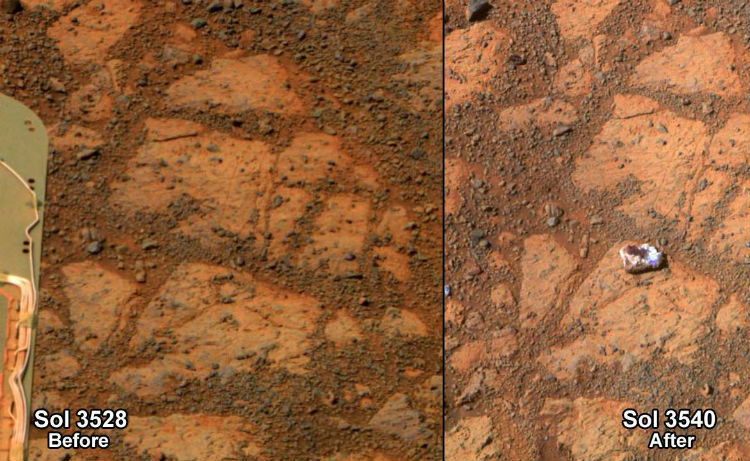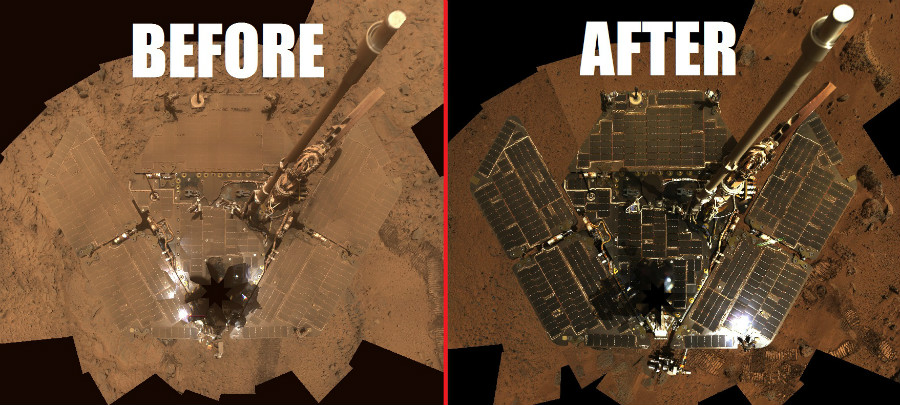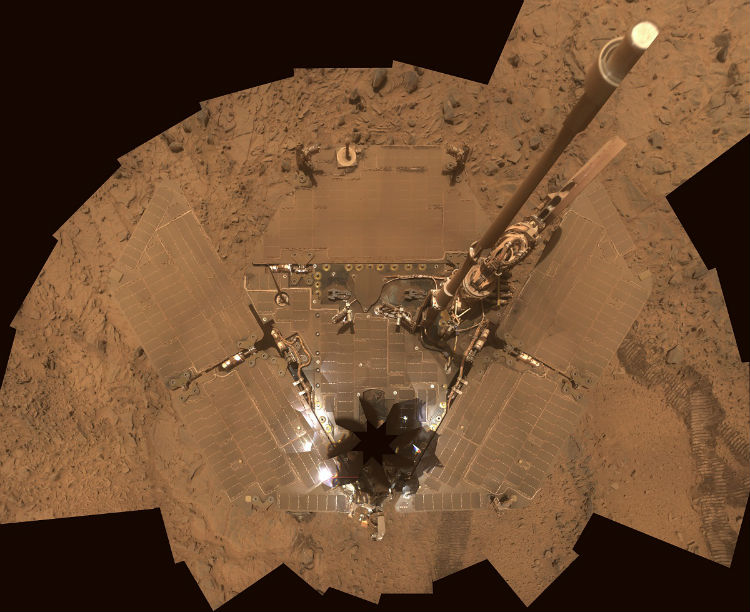Since Opportunity landed on Mars back in 2004, the red planet has gone around the sun 6.38 times. Earth has gone around the sun 12 times. That's 4265 sunrises on Mars, or 4380 sunrises on Earth (a Martian day is 24 hours, 39 minutes, and 35 seconds long)—or, about 70,000 sunrises on board the International Space Station.
Fast-forward twelve long, dusty years on Mars, and Opportunity is a long way beyond its planned 90-day shelf-life. NASA's twin Spirit and Opportunity rovers have become famous for their incredibly longevity—having only been designed to explore the surface of Mars for 90 days and travel up to 600 meters across its surface, both rovers have far exceeded the parameters of their primary mission.
Spirit operated for more than 5 years, traveling 7.73 kilometers until it became stuck in soft Martian soil. But sand hasn't been able to stifle the spirit of Opportunity, which in 2015 became the first robotic rover to travel the distance of a full Marathon (42.2 kilometers, or 26.2 miles) on the surface of another planet. Having landed three full years before the first iPhone launched in 2007 (back when selfies weren't really a thing yet), Opportunity is still going strong—and still snappin' slick selfies—right now in 2016.
 NASA's Opportunity rover taking a selfie on Mars. Image: NASA/JPL-Caltech/Cornell Univ./Arizona State Univ.
NASA's Opportunity rover taking a selfie on Mars. Image: NASA/JPL-Caltech/Cornell Univ./Arizona State Univ.
A planned 90 days extended to 12 years? Opportunity has lasted nearly 50 times longer than it was designed to. If we applied this same level of success to NASA's Curiosity rover that's been on Mars since 2012, with its planned two-year shelf-life, the most recent robotic addition to Martian soil should still be roving around Mars about a hundred years from now—up until the year 2112, give or take a few. Now over three years in: so far, so good.
But it's not easy. Temperatures on Mars can plummet as low as –125 Celsius, and the average daytime temperature is about –55 Celsius. Even worse, the dust of Mars is an eternal nemesis to any solar-powered adventurer: as the fine red powder accumulates on the rover's solar panels, less sunlight is able to get through, and the ability to generate electricity is greatly hampered. Add in the unforgiving terrain of Mars, featuring creeping sand dunes, jagged rocks, and uneven ground—the surface of Mars would be no easy task for a bipedal human to explore, let alone a robo-geologist on six wheels.
So how exactly has Opportunity sur-thrived in this harsh Martian environment? Well, I created a poll, and here are the results:
8% of Votes: Mechanics on Mars?
Can cars drive 12 consecutive years without ever needing an oil change? Can cars designed to travel around 200,000 kilometers without any major issues somehow manage 10 million kilometers without any sort of breakdown? The fact that Opportunity is able to continue doing science year after year without requiring any sort of repairs or sustaining any catastrophic injuries does seem suspicious.
Of course, there's the possibility that a team of native Martian mechanics has been working to keep Opportunity tuned-up and humming along. When the rover powers down at night (due to lack of sunlight), these camera-shy creatures conduct preventative repairs and general maintenance in the frigid Martian night. And just like waking up to see that Santa and his elves have left gifts (and raided the cookie jar), Opportunity begins each day having unwittingly received a fresh tune-up from a team of helpful Martians.
 This may or may not be a jelly donut left behind on Mars. Image: NASA/JPL-Caltech/Cornell/ASU.
This may or may not be a jelly donut left behind on Mars. Image: NASA/JPL-Caltech/Cornell/ASU.
Some evidence: NASA mission controllers were baffled to find this rock, imaged above, which seems to have appeared out of nowhere in a second photograph of the same spot. Nicknamed the 'Jelly Donut' by mission controllers, the official explanation is thatOpportunity somehow flipped the rock over with its wheel while performing a maneuver. But there's also another possibility: Martians did it. Or even more compelling, that the rock itselfis a Martian. There's some food for thought.
One factor to consider in support of this Martian Mechanic theorem is that Spirit has been incapacitated for half of a decade. Considering that both rovers were of identical construction, it seems odd that Opportunity has lasted nearly twice as long as Spirit when subjected to similar conditions and amount of use. One explanation here is that the team of Martian mechanics had been working on both rovers up until Spirit got a little too close to discovering a subterranean Martian city, at which point they sabotaged the rover by burying its wheels in sand.
Since then, the Martians have been slowly cannibalizing spare parts from Spirit in order to keep Opportunity in optimal condition. Why? Because Opportunity is nowhere near discovering evidence of Martian civilization—in essence, every passing day in whichOpportunity doesn't find evidence of Martian life further adds to the stack of anecdotal evidence that there are no aliens on Mars. Which is exactly what they want us to think.
 Opportunity exploring the Victoria Crater on Mars. Image: NASA/JPL-Caltech/University of Arizona/Cornell/Ohio State University.
Opportunity exploring the Victoria Crater on Mars. Image: NASA/JPL-Caltech/University of Arizona/Cornell/Ohio State University.
Another possible motivation for these Martian mechanics is manipulation of NASA's budget. With each passing year that Opportunity remains operational, tens of millions of dollars are spent by NASA in order to maintain the staff and facilities necessary to support the rover's expedition across the red planet. Far more advanced rovers are waiting to be sent to Mars, but as long as Opportunity continues trucking along and tying up resources back at NASA, building and sending new robots to Mars is not a top priority. Martians are waging a war of attrition against NASA by using their own super-successful rovers against them, but nobody even realizes it.
And this strategy is working: NASA recently announced that they're delaying the planned 2016 launch of Mars InSight, a lander designed to study the geology of Mars in more detail than ever before. Could this be a product of Opportunity's massively inflated operational budget siphoning funds away from the development of other robotic missions? Martians don't want humanity to discover that Mars' unique geology allows for giant underground cavern cities to exist just below the surface, a fact which InSight could certainly reveal, and which could potentially spark a renewed push for exploratory missions to Mars.
In fact, a staggering number of rovers and landers have failed while attempting to land on Mars. Could it be a product of sabotage? That these Martians don't want us to explore certain regions of their homeworld?
Obviously, this is all conjecture. The logic may be sound, but the evidence for a Martian civilization is non-existent (which, one could argue, is exactly what they want).
REAL PROBABILITY INDEX: LESS THAN 2%.
8% of Votes: Built With Alien Technology?
 Let's talk about alien technology... Image (left): George Stock. Image (right): Henrique Alvim Corréa.
Let's talk about alien technology... Image (left): George Stock. Image (right): Henrique Alvim Corréa.
The fact of the matter is that a significant percentage of the people who are interested in space exploration and astronomy also believe that aliens do exist... somewhere out there. This love for the concept of aliens is so pervasive that SETI recently announced a 10-year, $100 million dollar initiative to ramp up the search for intelligent alien civilizations. With this step-up in funding, SETI will be able to collect as much data in one day as they had previously only been able to collect in an entire year, which is a significant boost in capability.
But belief that alien life exists is much different from the belief that intelligent alien civilizations exist. And belief that these intelligent aliens may havevisited and crash-landed on Earth is an entirely different matter altogether.
As an analogy, look back at the pre-discovery of Antarctica. As early as the 5th century, 1600 years ago, there had been myths and even maps depicting Antarctica, a hypothetical 'southern land'. By the 15th century, many world maps included a representation of Antarctica drawn in despite the fact that this mythical landmass had never been sighted by men who lived to tell the tale. In the early 1800's, prominent explorers were claiming that there was 'no chance' of a landmass existing further south of Australia. This story runs parallel to the search for extraterrestrials.
Alas, in 1820, Antarctica was discovered.
Prior to discovery, it was generally accepted that a continent could exist at Earth's south polar region, just as it is generally accepted by experts that alien life probably does exist somewhere in the cosmos.
Much less widely accepted would have been the idea that Antarctica was teeming with wildlife and inhabited by previously unseen human beings. Being aware of the fact that Earth's north polar region is barren and practically uninhabited makes it somewhat illogical to presume that the same was not the case for the south polar region (although the prior discovery of the inhabited Americas would've made the discovery of an inhabited Antarctica slightly more plausible).
A preposterous suggestion would have been that Antarctica was not only inhabited by humans, but that it was inhabited by an incredibly advanced civilization unlike any encountered before—and that this civilization had frequently sent explorers to spy on the other continents, some of whom were captured and their advanced technologies seized, covered up, and eventually replicated by a few powerful nations (such as the British or French Empires).
The truth of the matter is that Antarctica did in fact exist, and it was sort of inhabited—by Emperor Penguins, a unique species of penguin not found anywhere else on Earth. Despite it being implausible that Antarctica was inhabited and especially that it was inhabited by an advanced civilization, there were minor truths hidden within these theories—yes, there was a colony of penguins living there, and yes, these penguins had likely been spotted by human beings outside of Antarctica. Of all those who had suggested an inhabited Antarctica, none had guessed an Antarctica inhabited by a previously unknown species of penguins.
In searching for extraterrestrial life in the cosmos, we should remain open to surprising possibilities.
Among those possibilities should not be included the idea that a crashed alien spacecraft was recovered, kept secret, and used to develop modern technology. And yet, the Roswell and Area 51 conspiracies have captivated public imagination and been featured in countless Science-Fiction films and books in which aliens are often depicted as mankind's greatest nemesis. But these hostile-alien Sci-Fi concepts are far too embedded within modern culture to be taken seriously, to the point where they can't even begin to be separated from the fiction in which they were invented. Where would we even start?
Further, there are far too many people involved for such a paradigm-shifting conspiracy to remain intact for 70 years. All it would take is a tiny bit of evidence—a metal alloy that can't be explained, a gadget of unworldly construction, a minuscule strand of DNA (or whatever these aliens are made of) that's unlike anything ever seen on Earth. UFO/Alien truthers may claim that this evidence already exists, but the scientific community would argue otherwise.
It's likely that we'll one day discover with certainty that we aren't alone in the cosmos—with SETI's renewed funding, perhaps even one day soon. But, as with Antarctica and its penguin colonists, we need hard evidence before we can begin to accept any wild claims.
It would be absolutely preposterous to claim that Antarctic penguins had once crossed the oceans, made contact with mankind, bestowed upon our ancestors the arts of agriculture and mathematics, and subsequently swam back to the frozen hell from whence they came.
One day in our cosmic not-so-lonely future, it may also sound absolutely preposterous to claim that an alien civilization had crossed the vast seas of the cosmos, visited our pale blue dot, made the comparatively juvenile mistake of crashing their spacecraft on Earth, failed to recover the wreckage, and then allowed a small minority of human beings to monopolize and weaponize this godlike alien technology to be employed to foolish ends.
But there's always a tiny chance...
REAL PROBABILITY INDEX: LESS THAN 1%
12% of Votes: Robot Super-Powers?
While Spirit and Opportunity were zipping through interplanetary space on their way to Mars, our sun spewed gamma rays out into the solar system in one of the most intense periods of solar flare activities ever witnessed by astronomers.
Mission controllers back at NASA were so concerned that these energized particles had damaged the rovers that they performed an unprecedented in-flight reboot in order to ensure no permanent damage had been done. The result of all of those gamma rays? The rovers appeared to be completely healthy.
In fact, gamma rays are the same radiation that gave Marvel's The Incredible Hulk his superpowers, allowing him to transform from brilliant physicist into an immortal rage-monster capable of inflicting immeasurable damage to whatever happened to annoy him that day. It's possible that a similar process is what granted the rovers their incredible longevity—Spiritlasted about 25 times longer than its planned 90-day mission, while Opportunity has lasted nearly 50 times longer (and still counting).
Even more amazingly, Opportunity has the power to blend into its environment like an octopus:
 Opportunity can blend in with its environment to hide from hostile Martians. Image (left): NASA/JPL-Caltech/Cornell. Image (right): NASA/JPL-Caltech/Cornell.
Opportunity can blend in with its environment to hide from hostile Martians. Image (left): NASA/JPL-Caltech/Cornell. Image (right): NASA/JPL-Caltech/Cornell.
Thanks to gamma rays, Opportunity may have transformed into the world's first super-hero geologist, fittingly taking the form of an interplanetary robot that's capable of covering itself in dust in order to blend in with its environment. Other powers include incredible durability, as Opportunity's 12 years spent exploring rugged Martian terrain have proven that it's approximately as tough as a rock—also, the ability to absorb energy from the sun in order to generate electricity (although gamma rays aren't responsible for this one, it was designed that way), sort of like the robot version of Superman.
Longevity, durability, camouflage, energy absorption, and the ability to traverse long distances—Opportunity is the ultimate covert operations agent for interplanetary reconnaissance. The proof is in the results, and this brave little rover should get its own comic book. Oh, here.
REAL PROBABILITY INDEX: 5%
13% of Votes: NASA is Faking it All?
While UFO/Alien truthers may simply be looked at as over-eager space fans who've watched a few too many made-for-internet documentaries, the group known as 'space deniers' are a mob of genuinely nasty creatures.
This group would have everyone believe that NASA has been faking the whole space thing since the 1960's, that Opportunity has lasted as long as it has simply because it's part of NASA's chosen narrative—an attempt to make the agency look better by having designed a robot capable of surviving for an unusually long amount of time on another planet.
According to these wretches, NASA's hangars don't actually contain any spacecraft, just hordes of retired Pixar animators photo-shopping next week's "images from outer space" collection.
 Is this image snapped of Victoria crater by Opportunity simply a CGI fraud? Image: NASA/JPL-Caltech/Cornell.
Is this image snapped of Victoria crater by Opportunity simply a CGI fraud? Image: NASA/JPL-Caltech/Cornell.
There comes a point in the complexity of this alleged conspiracy that it would become easier to simply go to space than it would be to perpetuate the forgery. Not necessarily for technical reasons, but for human reasons: over 500 astronauts have ventured into outer space, tens of thousands of personnel have directly supported the operations that put these astronauts in space, and hundreds of thousands of individuals have at some point worked on some aspect of the hardware that's been constructed over the past 60+ years to send both astronauts and robotic probes out into the cosmos.
The human factor simply presents too many loose ends and too many opportunities for disclosure, and now that private industry is getting involved, the whole fake spaceflight—cover-up—conspiracy thing is reaching a level of utter absurdity. Would SpaceX's Elon Musk, Blue Horizon's Jeff Bezos, or Virgin Galactic's Richard Branson, three technology entrepreneurs worth billions, allow themselves to be part of some government cover-up? For what purpose? Wouldn't it be more fun to just do space?
At least I think so.
REAL PROBABILITY INDEX: 0%
59% of Votes: Really Good Engineering.
Logic does prevail, as does the fact that some things are just built well. Despite its 90-day expiration date, Opportunity continues to blaze new trails 12 years on.
Opportunity Leaving Tracks Across Martian Dunes
 Roving the long and lonely road. Keep on truckin', Opportunity. Image: NASA/JPL/Cornell.
Roving the long and lonely road. Keep on truckin', Opportunity. Image: NASA/JPL/Cornell.
**But prior to Spirit and Opportunity reaching Mars in 2004, the world had seen a string of failures getting to the red planet: **
-
On September 23, 1999, NASA's Mars Climate Orbiter was lost due to a unit-conversion error; essentially, a contractor supplied a piece of hardware that calculated distance in U.S. Customary Units (feet and yards) whereas NASA software was designed to make calculations using Metric Units (meters). As a result, the probe plunged towards the surface of Mars and disintegrated rather than achieving orbit.
-
On December 3, 1999, telemetry data was sent from the Mars Polar Lander just prior to its descent to the Martian surface. No further contact was ever established, leading NASA to believe that the lander failed at some point on its way to the surface, possibly the result of a software error. A lack of proper funding was cited as a leading cause for the eventual failure.
-
On December 9, 2003, Japan's Nozomi spacecraft attempted to orient itself for a Mars orbital-insertion burn, but maneuvers failed and orbital insertion was abandoned. This failure came after a string of other mishaps, including a faulty fuel valve resulting in a fuel leak, a subsequent fuel shortage, and an altered trajectory that would allow the spacecraft to enter orbit around Mars at a lower velocity. However, after five years in space attempting to reach its target, the mission ultimately failed and only managed to zoom past Mars at escape velocity. Japan hasn't attempted another Mars mission since.
-
On December 25, 2003, ESA's Beagle 2 lander was expected to have reached the surface of Mars and made confirmation of its successful landing. However, no confirmation was ever received, and the fate of Beagle 2 remained a mystery for over a decade. In 2015, NASA's Mars Reconnaissance Orbiter found Beagle 2 on the surface of Mars, and images showed that the lander's solar panels failed to fully deploy. With its antenna trapped behind one of the un-deployed panels, the mission was rendered un-salvageable.
NASA certainly wasn't going to allow their follow-up mission to the Mars Polar Lander suffer the same fate, nor were they content to become the third and fourth consecutive Mars lander failures of the past few years. In order to ensure the success of their 2004 Mars Exploration Rovers mission, NASA employed the ultimate redundancy: two rovers built for the cost of one.
Spirit and Opportunity came at a time when Mars exploration was extremely difficult. And despite the great success of these brave little rovers, Mars still is difficult. Facing this reality, engineers at NASA were required to put everything they had into designing and building the rovers, and their success speaks for itself.
One factor to consider is that Spirit and Opportunity had to deal with a particularly rough landing: a system that employed giant inflatable airbags which bounced across the surface of Mars until finally rolling to a stop, at which point the rover then needed to be unpacked and driven clear of the airbag and landing platform. The requirement that the rovers be durable enough to survive the force of impacting the surface of Mars in a giant balloon likely contributed to their longevity further down the road.
 Dust may provide good camouflage, but at the expense of power... Image: NASA/JPL/Cornell.
Dust may provide good camouflage, but at the expense of power... Image: NASA/JPL/Cornell.
But it also took a little bit of luck. The real limiting factor in designing the 90-day mission was that NASA engineers expected both rovers to be so caked in dust (as seen above) within a few months that they would no longer be able to generate power. Surprisingly, the climate of Mars is such that it occasionally generates strong winds—a light breeze by Earth standards, but strong enough to clear a significant amount of accumulated dust off of the rovers every once and a while.
Without these cleaning events, the rovers would've been dead in the sand years ago. Sometimes, space exploration takes a little bit of good luck to counteract the bad—but in order for luck to play any kind of role in the first place, good engineering needs to come first.
REAL PROBABILITY INDEX: AT LEAST 92%
Building Success From Failure
NASA has always maintained a culture of building success off of its failures. When an oxygen tank exploded on Apollo 13 just two days into their trip to the Moon, mission control overcame extreme adversity and managed to return the spacecraft and crew safely to Earth. This experience led to future missions being designed with a significantly greater amount of system redundancy.
When the Challenger shuttle exploded 73 seconds into launch on January 28, 1986, the agency grounded its entire shuttle fleet and spent a few years greatly improving the safety mechanisms of the space shuttle. This disaster also forced NASA to overhaul its internal communications channels, allowing engineers greater opportunity to raise concerns about potential issues without fear of backlash.
Similarly, a string of failures leading up to landing the Mars Exploration Rovers provided NASA with the drive to make Spirit and Opportunity as successful as possible. What Opportunity's long life on Mars ultimately shows us is that we can learn from failures, we can learn from successes, and sometimes, when good engineering combines with a little bit of luck, amazing results can be achieved.




